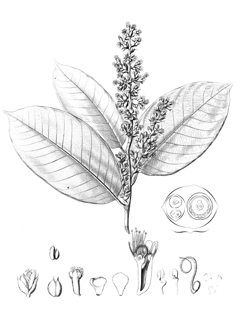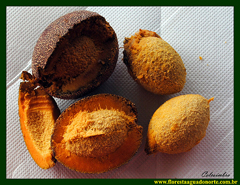 |
|
https://edibleplants.org/ |
 |
| flickr |
Translate this page:
Summary
Coupeia bracteosa, otherwise known as Pajura, is a popular evergreen fruit tree of up to 20 m in height with a dense and narrow crown, leathery dark green leaves, and white small flowers that forms into clusters in the leaf axils and at the end of branches. The fruit is oval and has a thick, aromatic, oily pulp with a thin skin and a sweet flavour. It can be eaten raw and it has high oil content. The wood is heavy, very durable and used for external carpentry.
Amazon, Bolivia, Brazil, Central America, Colombia, French Guiana, Guianas, Guyana, Peru, South America, Suriname, Venezuela. Also known as: Aruadan, Coro, Marirana, Oiti, Olosapo, Pajura de mata, Pajura-de-racha, Pajura-verdadeiro.
Physical Characteristics

 Couepia bracteosa is an evergreen Tree growing to 15 m (49ft) by 15 m (49ft) at a medium rate.
Couepia bracteosa is an evergreen Tree growing to 15 m (49ft) by 15 m (49ft) at a medium rate.
See above for USDA hardiness. It is hardy to UK zone 10.
Suitable for: light (sandy), medium (loamy) and heavy (clay) soils and prefers well-drained soil. Suitable pH: mildly acid, neutral and basic (mildly alkaline) soils. It can grow in semi-shade (light woodland) or no shade. It prefers moist soil.
UK Hardiness Map
US Hardiness Map
Synonyms
Moquilea bracteosa (Benth.) Walp. Moquilea rufa Barb.Rodr.
Plant Habitats
Edible Uses
Edible Parts: Fruit
Edible Uses:
Fruit - raw[ 416 ]. A thick, aromatic, oily pulp with a thin skin and a sweet, pleasant flavour[ 416 ]. The fruit is up to 13cm long and 10cm wide[ 416 ].
References More on Edible Uses
Medicinal Uses
Plants For A Future can not take any responsibility for any adverse effects from the use of plants. Always seek advice from a professional before using a plant medicinally.
None known
References More on Medicinal Uses
The Bookshop: Edible Plant Books
Our Latest books on Perennial Plants For Food Forests and Permaculture Gardens in paperback or digital formats.

Edible Tropical Plants
Food Forest Plants for Hotter Conditions: 250+ Plants For Tropical Food Forests & Permaculture Gardens.
More

Edible Temperate Plants
Plants for Your Food Forest: 500 Plants for Temperate Food Forests & Permaculture Gardens.
More

More Books
PFAF have eight books available in paperback and digital formats. Browse the shop for more information.
Shop Now
Other Uses
Wood
Other Uses: The wood is heavy, difficult to work, very durable and only slightly susceptible to wood-eating organisms[ 625 ]. It is used for external carpentry[ 625 ].
Special Uses
Food Forest
References More on Other Uses
Cultivation details
A tropical plant. Succeeds in a sunny position or light shade[ 625 ]. Newly planted young trees grow away moderately well. A popular cultivated fruit tree.
References Carbon Farming Information and Carbon Sequestration Information
Temperature Converter
Type a value in the Celsius field to convert the value to Fahrenheit:
Fahrenheit:
The PFAF Bookshop
Plants For A Future have a number of books available in paperback and digital form. Book titles include Edible Plants, Edible Perennials, Edible Trees,Edible Shrubs, Woodland Gardening, and Temperate Food Forest Plants. Our new book is Food Forest Plants For Hotter Conditions (Tropical and Sub-Tropical).
Shop Now
Plant Propagation
Seed - best sown as soon as it is ripe, in individual containers in partial shade[ 625 ]. The germination rate is usually low, with the seeds taking several weeks before they sprout[ 625 ]. The seeds are collected from very ripe fruit that have the pulp washed out. The seeds should be planted fresh.
Other Names
If available other names are mentioned here
Coupeia bracteosa, otherwise known as Pajura. Also known as: Aruadan, Coro, Marirana, Oiti, Olosapo, Pajura de mata, Pajura-de-racha, Pajura-verdadeiro.
Native Range
SOUTHERN AMERICA: French Guiana, Guyana, Suriname, Brazil, Amazonas, Pará, Amapá, Rondônia, Bolivia, Pando, Colombia, Vaupés, Peru, Loreto,
Weed Potential
Right plant wrong place. We are currently updating this section.
Please note that a plant may be invasive in one area but may not in your area so it's worth checking.
None Known
Conservation Status
IUCN Red List of Threatened Plants Status : This taxon has not yet been assessed

Growth: S = slow M = medium F = fast. Soil: L = light (sandy) M = medium H = heavy (clay). pH: A = acid N = neutral B = basic (alkaline). Shade: F = full shade S = semi-shade N = no shade. Moisture: D = dry M = Moist We = wet Wa = water.
Now available:
Food Forest Plants for Mediterranean Conditions
350+ Perennial Plants For Mediterranean and Drier Food Forests and Permaculture Gardens.
[Paperback and eBook]
This is the third in Plants For A Future's series of plant guides for food forests tailored to
specific climate zones. Following volumes on temperate and tropical ecosystems, this book focuses
on species suited to Mediterranean conditions—regions with hot, dry summers and cool, wet winters,
often facing the added challenge of climate change.
Read More
Expert comment
Author
Benth.
Botanical References
Links / References
For a list of references used on this page please go here
A special thanks to Ken Fern for some of the information used on this page.
Readers comment
| Add a comment |
|
If you have important information about this plant that may help other users please add a comment or link below. Only comments or links that are felt to be directly relevant to a plant will be included. If you think a comment/link or information contained on this page is inaccurate or misleading we would welcome your feedback at [email protected]. If you have questions about a plant please use the Forum on this website as we do not have the resources to answer questions ourselves.
* Please note: the comments by website users are not necessarily those held by PFAF and may give misleading or inaccurate information.
To leave a comment please Register or login here All comments need to be approved so will not appear immediately.
|
Subject : Couepia bracteosa
|
|
|
|